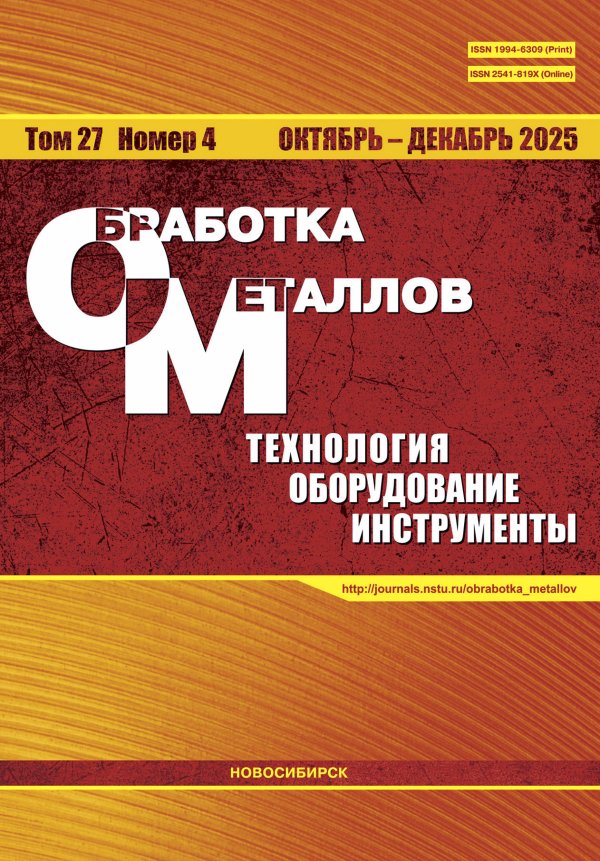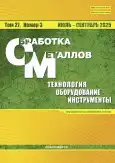Особенности строения градиентных слоев «сталь – Inconel – сталь», полученных методом прямого лазерного выращивания
- Авторы: Долгова С.В.1, Маликов А.Г.2, Голышев А.А.2, Никулина А.А.3
-
Учреждения:
- Новосибирский завод полупроводниковых приборов «Восток»
- Институт теоретической и прикладной механики им. С.А. Христиановича СО РАН
- Новосибирский государственный технический университет
- Выпуск: Том 27, № 3 (2025)
- Страницы: 205-220
- Раздел: Статьи
- URL: https://bakhtiniada.ru/1994-6309/article/view/308850
- DOI: https://doi.org/10.17212/1994-6309-2025-27.3-205-220
- ID: 308850
Цитировать
Аннотация
Введение. Традиционно наиболее распространенной технологией получения деталей из никелевых сплавов является литье с последующей термической обработкой для формирования необходимого фазового состава. Существенными недостатками материала в данном случае считаются сегрегация химических элементов, наличие крупных нежелательных включений фазы Лавеса и эвтектик, а также неравномерное распределение упрочняющих фаз по сечению заготовки. При этом многие сложнопрофильные детали собираются в единую комбинированную конструкцию с использованием сварки. Анализ особенностей упрочнения никелевых сплавов и изделий, которые изготавливают из них, показывает, что перспективным способом формирования таких заготовок являются аддитивные технологии. Структура и фазовый состав объемов материала, формируемых послойным нанесением, будет существенно отличаться от материалов, получаемых традиционными способами. В случае получения комбинированных конструкций аддитивными способами выявление закономерностей формирования структуры и фазового состава материалов становится еще более сложной задачей. Поэтому цель данной работы заключается в выявлении особенностей строения градиентных слоев «сталь – никелевый сплав – сталь», полученных методом прямого лазерного выращивания. В работе исследованы разнородные соединения, изготовленные с использованием установки «Наплавочно-сварочный комплекс на базе многокоординатной руки и волоконного лазера» в Институте теоретической и прикладной механики им. С.А. Христиановича СО РАН и c реализацией технологии прямого лазерного выращивания. Методы исследования. Для структурных исследований полученных слоев применялись световой микроскоп Carl Zeiss A1Z и растровый электронный микроскоп Carl Zeiss EVO 50 XVP с энергодисперсионной приставкой INCA X-Act. Фазовый состав образцов определяли на рентгеновском дифрактометре ARL X’;TRA. Дюрометрические испытания проводили на твердомере по Виккерсу Wolpert Group 402 MVD. Результаты и обсуждение. Установлено, что максимальная высота массивов (до 7 мм) формируется при реализации режимов 1000 Вт, скорость сканирования 35 мм/с; 1500 Вт, скорость сканирования 15 мм/с; при этом в первом случае происходит минимальное перемешивание материалов на границе сплавления. Во всех композициях присутствуют дефекты в виде не расплавившихся частиц порошка, а также трещины в первых слоях стали. При наплавке Inconel 625 на сталь 316L в переходной зоне, где по химическому составу образуются сплавы на основе железа, последовательно реализуются режимы затвердевания FA (феррит – аустенит), AF (аустенит – феррит) и A (аустенит). При наплавке стали 316L на Inconel 625 в переходной зоне реализуется режим затвердевания с образованием только фазы аустенита. Уровень микротвердости для стали 316L составляет 230 ±15 HV, для Inconel 625 он равен 298 ± 20 HV.
Об авторах
Светлана Васильевна Долгова
Новосибирский завод полупроводниковых приборов «Восток»
Email: svetlanadolgova99@gmail.com
ORCID iD: 0000-0003-3918-273X
Scopus Author ID: 57203801980
ведущий инженер-технолог
Россия, ул. Дачная, 60, г. Новосибирск, 630082, РоссияАлександр Геннадьевич Маликов
Институт теоретической и прикладной механики им. С.А. Христиановича СО РАН
Email: smalik707@yandex.ru
ORCID iD: 0000-0003-1268-8546
SPIN-код: 2488-7130
Scopus Author ID: 22941697700
ResearcherId: O-9762-2015
https://scholar.google.com/citations?user=lNeQeMQAAAAJ
доктор техн. наук, ведущий научный сотрудник
Россия, ул. Институтская, 4/1, г. Новосибирск, 630090Александр Анатольевич Голышев
Институт теоретической и прикладной механики им. С.А. Христиановича СО РАН
Email: alexgol@itam.nsc.ru
ORCID iD: 0000-0002-4243-0602
SPIN-код: 4619-9480
Scopus Author ID: 14521123300
ResearcherId: P-1678-2015
https://scholar.google.com/citations?user=Y2kgs8cAAAAJ&hl=ru
канд. физ.-мат. наук, старший научный сотрудник
Россия, ул. Институтская, 4/1, г. Новосибирск, 630090, РоссияАэлита Александровна Никулина
Новосибирский государственный технический университет
Автор, ответственный за переписку.
Email: a.nikulina@corp.nstu.ru
ORCID iD: 0000-0001-9249-2273
SPIN-код: 7600-8285
Scopus Author ID: 25031513500
ResearcherId: A-3467-2014
https://ciu.nstu.ru/kaf/persons/20084/
зав. кафедрой, доктор техн. наук, доцент
Россия, пр. К. Маркса, 20, г. Новосибирск, 630073, РоссияСписок литературы
- Effect of nickel-based filler metal types on creep properties of dissimilar metal welds between Inconel 617B and 10 % Cr martensitic steel / Y. Zhang, M. Hu, Z. Cai, C. Han, X. Li, X. Huo, M. Fan, S. Rui, K. Li, J. Pan // Journal of Materials Research and Technology. – 2021. – Vol. 14. – P. 2289–2301. – doi: 10.1016/j.jmrt.2021.07.131.
- Fabrication of steel-Inconel functionally graded materials by laser melting deposition integrating with laser synchronous preheating / W. Meng, W. Zhang, W. Zhang, X. Yin, B. Cui // Optics & Laser Technology. – 2020. – Vol. 131. – P. 106451. – doi: 10.1016/j.optlastec.2020.106451.
- Naffakh H., Shamanian M., Ashrafizadeh F. Dissimilar welding of AISI 310 austenitic stainless steel to nickel-based alloy Inconel 657 // Journal of materials processing technology. – 2009. – Vol. 209 (7). – P. 3628–3639. – doi: 10.1016/j.jmatprotec.2008.08.019.
- Reed R.C. The superalloys: fundamentals and applications. – Cambridge: Cambridge university press, 2008. – 363 p. – ISBN 9780511541285. – doi: 10.1017/CBO9780511541285.
- Inconel 718: A solidification diagram / G.A. Knorovsky, M.J. Cieslak, T.J. Headley, A.D. Romig, W.F. Hammetter // Metallurgical transactions A. – 1989. – Vol. 20 (10). – P. 2149–2158. – doi: 10.1007/BF02650300.
- Investigation on the Laves phase formation during laser cladding of IN718 alloy by CA-FE / H. Xie, K. Yang, F. Li, C. Sun, Z. Yu// Journal of Manufacturing Processes. – 2020. – Vol. 52. – P. 132–144. – doi: 10.1016/j.jmapro.2020.01.050.
- Effects of heat treatments on the microstructure of IN792 alloy / J. Yang, Q. Zheng, H. Zhang, X. Sun, H. Guan, Z. Hu // Materials Science and Engineering: A. – 2010. – Vol. 527 (4–5). – P. 1016–1021. – doi: 10.1016/j.msea.2009.10.026.
- Рашковец М.В. Структура и свойства никелевых сплавов, полученных по аддитивной технологии с использованием метода прямого лазерного выращивания: дис. … канд. техн. наук. – Новосибирск, 2022. – 164 с.
- Deshpande A. Additive manufacturing of nickel alloys // Springer handbook of additive manufacturing. – Cham: Springer, 2023. – P. 655–669. – ISBN 978-3-031-20751-8. – doi: 10.1007/978-3-031-20752-5_39.
- Microstructures and mechanical behavior of the bimetallic additively-manufactured structure (BAMS) of austenitic stainless steel and Inconel 625 / Md. R.U. Ahsan, X. Fan, G.-J. Seo, C. Ji, M. Noakes, A. Nycz, P.K. Liaw, D.B. Kim // Journal of Materials Science & Technology. – 2021. – Vol. 74. – P. 176–188. – doi: 10.1016/j.jmst.2020.10.001.
- Functionally graded material of 304L stainless steel and Inconel 625 fabricated by directed energy deposition: Characterization and thermodynamic modeling / B.E. Carroll, R.A. Otis, J.P. Borgonia, J. Suh, R.P. Dillon, A.A. Shapiro, D.C. Hofmann, Z.-K. Liu, A.M. Beese // Acta Materialia. – 2016. – Vol. 108. – P. 46–54. – doi: 10.1016/j.actamat.2016.02.019.
- Inconel-steel functionally bimetal materials by hybrid directed energy deposition and thermal milling: Microstructure and mechanical properties / P. Li, Y. Gong, Y. Xu, Y. Qi, Y. Sun, H. Zhang // Archives of Civil and Mechanical Engineering. – 2019. – Vol. 19 (3). – P. 820–831. – doi: 10.1016/j.acme.2019.03.002.
- Microstructure and mechanical properties of stainless steel 316L-Inconel 625 bimetallic structure fabricated by laser wire direct energy deposition / S. Tyagi, S.K. Balla, M. Manjaiah, C. Aranas // Journal of Materials Research and Technology. – 2024. – Vol. 33. – P. 8361–8371. – doi: 10.1016/j.jmrt.2024.11.130.
- Design optimization for defect-free AISI 316 L/IN718 functionally graded materials produced by laser additive manufacturing / R. Ghanavati, H. Naffakh-Moosavy, M. Moradi, F. Mazzucato, A. Valente, S. Bagherifard, A. Saboori // Materials Characterization. – 2025. – Vol. 220. – P. 114697. – doi: 10.1016/j.matchar.2024.114697.
- High temperature fracture behavior of 316L stainless steel-Inconel 718 functionally graded materials manufactured by directed energy deposition: Role of interface orientation and heat treatment / Y. Li, M. Koukolíková, J. Dzugan, M. Brázda // Materials Science and Engineering: A. – 2024. – Vol. 898. – P. 146389. – doi: 10.1016/j.msea.2024.146389.
- Влияние режимов лазерной наплавки на геометрические размеры стального трека / С.В. Долгова, А.Г. Маликов, А.А. Голышев, А.А. Никулина // Обработка металлов (технология, оборудование, инструменты). – 2024. – Т. 26, № 2. – С. 57–70. – doi: 10.17212/1994-6309-2024-26.2-57-70.
- Microstructural characteristics and crack formation in additively manufactured bimetal material of 316L stainless steel and Inconel 625 / N. Chen, H.A. Khan, Z. Wan, J. Lippert, H. Sun, S.-L. Shang, Z.-K. Liu, J. Li // Additive Manufacturing. – 2020. – Vol. 32. – P. 101037. – doi: 10.1016/j.addma.2020.101037.
- Review of in-situ process monitoring and in-situ metrology for metal additive manufacturing / S.K. Everton, M. Hirsch, P. Stravroulakis, R.K. Leach, A.T. Clare // Materials & Design. – 2016. – Vol. 95. – P. 431–445. – doi: 10.1016/j.matdes.2016.01.099.
- Interfacial characterization and mechanical properties of 316L stainless steel/Inconel 718 manufactured by selective laser melting / X. Mei, X. Wang, Y. Peng, H. Gu, G. Zhong, S. Yang // Material Science and Engineering: A. – 2019. – Vol. 758. – P. 185–191. – doi: 10.1016/j.msea.2019.05.011.
- Laser Beam Direct Energy Deposition of graded austenitic-to-martensitic steel junctions compared to dissimilar Electron Beam welding / F. Villaret, X. Boulnat, P. Aubry, Y. Yano, S. Ohtsuka, D. Fabrègue, Y. de Carlan // Materials Science and Engineering: A. – 2021. – Vol. 824. – P. 141794. – doi: 10.1016/j.msea.2021.141794.
- Astafurov S., Astafurova E. Phase composition of austenitic stainless steels in additive manufacturing: A review // Metals. – 2021. – Vol. 11 (7). – P. 1052. – doi: 10.3390/met11071052.
- Pouranvari M., Khorramifar M., Marashi S.P.H. Ferritic–austenitic stainless steels dissimilar resistance spot welds: metallurgical and failure characteristics // Science and Technology of Welding and Joining. – 2016. – Vol. 21 (6). – P. 438–445. – doi: 10.1080/13621718.2015.1124491.
Дополнительные файлы







